
Native Plants
Featuring American Beauties Native Plants
Callirhoe involucratawine cups, purple poppymallow
An outstanding and very attractive plant with low growing, deeply dissected dark green foliage that gives rise to an explosion of electric purple, single, upright flowers from July to early September. This plant behaves like an ivy. It is taprooted and can be difficult in containers if not well spaced. Let it drape over stone walls or creep between stones. Requires full sun and good drainage. Native to the Midwest.
[
More Info
]
|
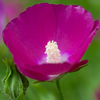
|
Caltha palustrismarsh marigold
Native to northern states and Canada, this little beauty is at home at pond's edge or along a stream. It is clumping by nature, but can seed in to form a dense groundcover in a consistently moist site. In early spring, hundreds of bright yellow buttercup flowers dot the green carpet of cordate foliage. Deer usually leave this alone! Found in marshes, swamps, and wet meadows from North Carolina to Alaska. [
More Info
]
|
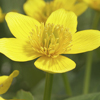
|
Carex amphibolacreek sedge
Carex amphibola is a widely adaptable native sedge naturally occurring from Texas to Quebec and Georgia to New Hampshire. Its forms a compact and semi-erect mound. Proven to be semi evergreen (zone 6b) and prefers deciduous shade in upland or even floodplain conditions; easily adapts to fine or medium textured soils. Creek sedge lends itself well to native shade gardens, along wood paths or as a slope stabilizer. It is a vigorous clump former with shiny, narrow green foliage 1/8" wide by up to 12" long. C. amphibola is an excellent companion for Phlox divaricata, Chrysogonum and Polygonatum...among others! [
More Info
]
|
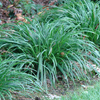
|
Carex appalachicaAppalachian sedge
This lovely sedge is native to the dry woods of eastern North America. Its fine texture and fountaining habit make it a lovely groundcover in dry shady sites, even in the root zone of trees. Its tidy clumping habit makes it a perfect feature in a container, rock or stump, or in a border planting along a walkway. [
More Info
]
|
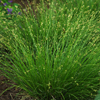
|
Carex cherokeensisCherokee sedge
Carex cherokeensis is a native sedge with a soft-medium texture. It prefers moist conditions but is adaptive. Grows in part shade but tolerates full sun in the morning. The inflorescence has been noted as insignificant but, we like the little wispy spikes that add a interest in the spring. [
More Info
]
|
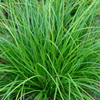
|
Carex eburneabristleleaf sedge
A wonderful naturalizer, Carex eburnea is the ideal native groundcover for the woodland or rock garden. Petite colonies of 6-8 inch long soft, thread-like foliage takes on a spherical shape as inconspicuous whitish-green flower spikes appear in early spring. [
More Info
]
|
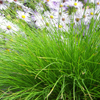
|
Carex flaccospermablue wood sedge
A beautiful native groundcover with striking glaucus blue foliage, Blue wood sedge is easy to grow and evergreen in warmer zones, though it benefits from a late winter cut back. Early spring flowers are slender and form interesting seed heads. Forms tidy clumps and spreads by seed. [
More Info
]
|
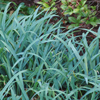
|
Carex laxiculmus Bunny Blue® 'HOBB'Bunny Blue sedge
Bunny Blue® is a low growing, evergreen, native sedge with silver-blue foliage. Use as a ground cover or specimen plant for moist to average shady areas. [
More Info
]
|
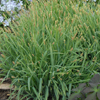
|
Carex muskingumensisMuskingum sedge
A fine-textured sedge that resembles palm fronds? How strange! Naturally occuring in moist habitats such as low, swampy woods and wet meadows, this native cool-season sedge adds textural interest to any planting. [
More Info
]
|
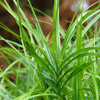
|
Carex pensylvanicaoak sedge
With its tough disposition and spreading habit, this native sedge makes an excellent shade groundcover. Fine texture and fountaining habit give this sedge a soft appearance that is lovely as an underplanting for bolder shade perennials or on its own as a shade lawn. Great in containers too! Easy to grow. Happiest in the company of oaks, but who isn't? [
More Info
]
|
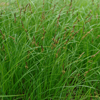
|
Carex plantagineaseersucker sedge
Shiny deep green leaves are unusually broad (to 1 1/8") and puckered like Christmas ribbon. An excellent, mostly evergreen (the basal foliage overwinters) groundcover for average to moist shade, provides unique texture. Flowers occur in early to mid-spring, thin and black-tipped, not especially showy. Found in moist woods from Canada to Alabama.
[
More Info
]
|
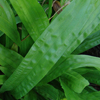
|
Carex radiataeastern star sedge
An attractive native sedge that forms dense tufts of foliage reaching 1–2' in height with an equal spread. Inflorescences range from 1-3" in length; blooming late spring. Very adaptable, dappled sunlight to medium shade, moist to mesic conditions, and a rich loamy soil with abundant organic matter. Incorporate with native ferns or spring ephemerals like Mertensia virginica. Seeds are enjoyed by various songbirds. [
More Info
]
|
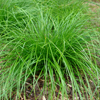
|
Carex rosearosy sedge
Carex rosea, or rosy sedge, is a petite woodland sedge with fine-textured foliage and elegant star-like flower clusters that appear in spring. Topping out at roughly a foot tall, the tidy bright green clumps provide form and function when used en masse—or is just as noticeable dotted about the landscape. [
More Info
]
|
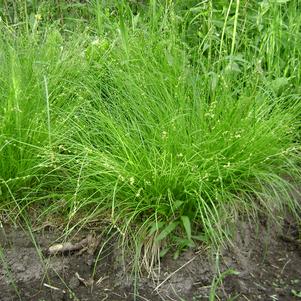
|
Carex strictatussock sedge
A wetland native that forms dense tussocks of straw-colored leaves at the base with bright green new growth emerging from the top. Spreads via rhizomes. Found in wet meadows. Emergent aquatic. [
More Info
]
|
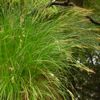
|
Carex vulpinoideafox sedge
One of the most widespread species of Carex in North America, growing in wet meadows, prairies, swamps and marshes. The seedheads mature in late summer and resemble fox tails, hence the common name. [
More Info
]
|
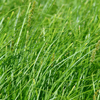
|
Chasmanthium latifoliumnorthern sea oats
A versatile native grass with bamboo-like foliage and delightful nodding seed heads that rustle in the breeze from late summer to winter. It grows in most sites and is a quite vigorous groundcover when given consistent moisture and sun. It is better behaved in average garden conditions and in shade. A unique cut flower in fresh or dry arrangements. [
More Info
]
|
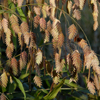
|
Chelone glabraturtlehead
Spikes of elegant white flowers top shiny green foliage in late summer and early fall. Grows best in moist meadows, stream banks, and swamps. Favorite breeding site for the Baltimore Checkerspot Butterfly. [
More Info
]
|
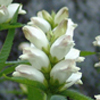
|
Chelone lyonii 'Hot Lips'turtlehead
Lustrous, deep green foliage is topped in August and September with rose pink, turtle-head-shaped flowers. Red stems persist most of the season. Bronze green early season growth is another distinctive feature. [
More Info
]
|
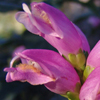
|
Chelone obliqua Tiny Tortuga™ 'Armitpp02' PP25350turtlehead
A tiny turtlehead with all the flower power of its taller brothers, this native cultivar features uniquely shaped, hot pink blooms atop lustrous dark green leaves with a bronzy sheen. Flowers reminiscent of turtles' mouths persist from mid-summer into fall, a favorite of butterflies but distasteful to deer. Its very compact habit is a great choice for mixed containers, or let it spread ever so slowly in the landscape along pond and stream edges, rain gardens or perennial borders. [
More Info
]
|
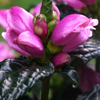
|
Chrysogonum virginianum 'Allen Bush'green and gold
A native groundcover, this plant is known for both its foliage and flowers with toothed, light green, triangular leaves and dark yellow, slightly notched, star shaped flowers that bloom well above the foliage and have contrasting brown stamens. The flowers bloom abundantly in the spring and fall, but tend to die down in the heat of the summer except in the cooler zones. [
More Info
]
|
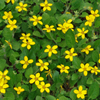
|
Chrysogonum virginianum 'Superstar'green and gold
This green and gold is sure to be a superstar on the retail bench and in the garden! Deep green, semi-evergreen foliage is topped with golden flowers in mid to late spring. It’s an easy native groundcover that blooms well and is a vigorous clump grower. [
More Info
]
|
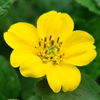
|
Chrysogonum virginianum var. australegreen and gold
One of our favorite native groundcovers for the woodland garden. Yellow daisy-like flowers cover 6" evergreen foliage in spring. Rosettes of leaves slowly spread stoloniferously. Looks great with columbine and Virginia bluebells. This golden star is very similar to Chrysogonum virginianum 'Allen Bush', but has shorter stems and stolons that spread above ground. With a compact and low growing form, this plant has deep, shiny green foliage and golden, star shaped flowers. [
More Info
]
|
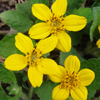
|
Clematis virginianaold man's beard
Blooming in late summer-early fall, this vigorous native Clematis virginiana is covered in showy, sweetly-scented white flowers that are 1" across. A fine addition to fences, on trellises, or trained up trees, Virgin's bower grows 12-20' tall. Commonly found in moist, woodland edge areas east of the Mississippi, it grows well in full sun but also can tolerate dry shade. [
More Info
]
|
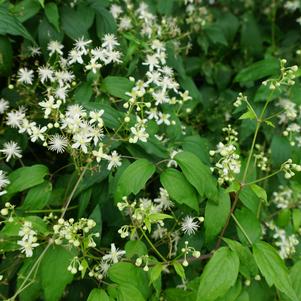
|
Coreopsis 'Crème Brûlée' PP16096tickseed
A more vigorous version of 'Moonbeam' that fills in faster in the spring and has larger flowers that occur all along the stems rather than just above the foliage, giving a fuller overall appearence. Overwinters well. [
More Info
]
|
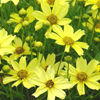
|
Coreopsis palustris 'Summer Sunshine'swamp tickseed
Vigorous mounds of foliage reach up to a sturdy 30” tall. Flower display lasts for a full 6 weeks. Bright and sunny for end of summer blooming that holds through the fall. C. palustris is native to the swampy forests of the south and particularly prolific in the Carolinas. It is one of the slower spreading Coreopsis and is a faculative that tolerates wet roots for extended periods. Mt. Cuba Center's 2015 Coreopsis Trial [
More Info
]
|
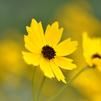
|
Coreopsis pubescens 'Sunshine Superman'star tickseed
A North Creek original, this selection of C. pubescens var. pubescens blooms non-stop from mid-summer until October here, with saucer-like flowers over low, spreading, slightly fuzzy foliage. An easy, self-sowing plant when happy. Likes hot, bright, well-drained spots, but is not fussy at all. An easy native for sun or part shade. [
More Info
]
|
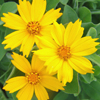
|
Coreopsis tripteris 'Gold Standard'tall tickseed
This accession of C. tripteris was collected by Mt. Cuba Center in the wild and shows better garden performance than the straight species. This plant is approximately 1’ shorter and blooms for an additional six weeks. The flowers were also born on shorter, secondary growth. This characteristic distributed the floral display throughout the entire plant rather than solely at the top. The cultivar name of 'Gold Standard' was assigned at the completion of the trial due to this selections superior performance compared to the straight species. Mt. Cuba Center Coreopsis Trial 2015 [
More Info
]
|
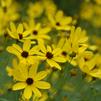
|
Coreopsis verticillata 'Moonbeam'whorled tickseed
Coreopsis 'Moonbeam' is a dependable bloomer and all-round fantastic plant. The flowers are a glowing, lemon-yellow color and sit on top of tall, erect, lacey, somewhat mound forming, delicate (threadleaf) looking green foliage that has an airy appearance. The flowers are plentiful and bloom continuously throughout the entire summer. If the dead blossoms are removed, flowers will be more abundant and healthy. Truly a bright sight. Great in rock gardens and gardens with poor soil. Makes a nice cut flower. [
More Info
]
|
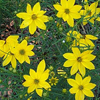
|
Coreopsis verticillata 'Zagreb'whorled tickseed
Winner of the 2001 RHS Award of Garden Merit, this threadleaf coreopsis is just a little bit shorter than 'Moonbeam'. 'Zagreb' has bright yellow flowers that sit atop tall, erect, lacey, somwhat mound forming, delicate (threadleaf) looking, green foliage that has an airy appearance. The flowers are abundant and bloom continuously throughout the entire summer. Removal of the dead blossoms encourages longer blooming and healthier flowers. Truly a colorful sight. Great in rock gardens and gardens with poor soil. Makes a good cut flower. [
More Info
]
|
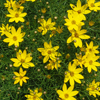
|
Coreopsis verticillatawhorled tickseed
This hardy species is a delightful and tough landscape solution. Taller and more vigorous than 'Moonbeam' or 'Zagreb', it has bright yellow flowers for 8 weeks or more, from late May to early August and often later. Drought tolerant and easy to grow in a garden or along the roadside. [
More Info
]
|
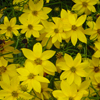
|

